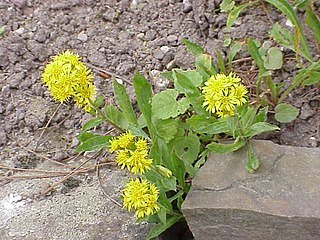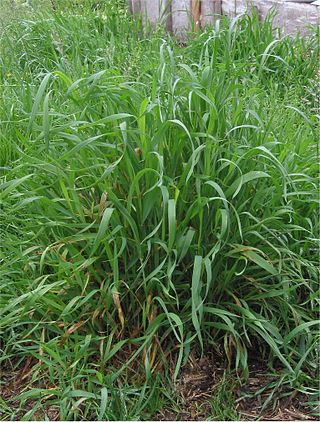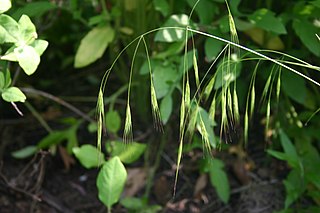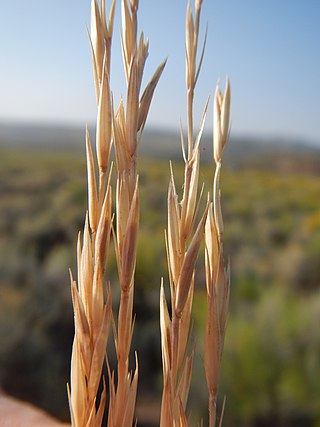
Solidago virgaurea, the European goldenrod or woundwort, is an herbaceous perennial plant of the family Asteraceae. It is widespread across most of Europe as well as North Africa and northern, central, and southwestern Asia. It is grown as a garden flower with many different cultivars. It flowers profusely in late summer.

Elymus repens, commonly known as couch grass, is a very common perennial species of grass native to most of Europe, Asia, the Arctic, and northwest Africa. It has been brought into other mild northern climates for forage or erosion control, but is often considered a weed.

Elymus is a genus of perennial plants with approximately 150 species in the grass family, related to rye, wheat, and other widely grown cereal grains.

Halothamnus subaphyllus is a species of the plant genus Halothamnus, that belongs to the subfamily Salsoloideae within the family Amaranthaceae,. It occurs in Southwest and Central Asia.

Halothamnus glaucus is a species of the plant genus Halothamnus, that belongs to the subfamily Salsoloideae of the family Amaranthaceae,. It occurs in Western and Central Asia.

Eremopyrum is a genus Eurasian and North African plants in the grass family. One species, Eremopyrum triticeum has become widely established as a weed in parts of North America.

Schizachne is a genus of Eurasian and North American plants in the grass family. The only accepted species is Schizachne purpurascens, commonly called false melic. Three subspecies are recognized:

Ajania is a genus of flowering plants in the daisy family, described as a genus in 1955. The genus is native to temperate Asia, primarily Russia and China. It is named after the Russian port city Ayan in the Khabarovsk Krai region of the Russian Far East, on the coast of the Sea of Okhotsk.
Hippolytia is a genus of flowering plants in the daisy family native to temperate Asia.

Kaschgaria is a genus of flowering plants in the daisy family.

Lepidolopsis is a genus of flowering plants in the daisy family. Its species are native to Central Asia and Afghanistan. The plant has bright yellow flowers that come from a green stem.
Microcephala is a genus of Asian flowering plants in the chamomile tribe within the daisy family.
Vladimir Andreevich Tranzschel was a Russian and later Soviet botanist, mycologist and plant pathologist, especially an expert on rust fungi.

Ribes pallidiflorum is a species in the genus Ribes native to the far east, from northeastern China to Russia.

Leymus salina is a species of grass known as Salina wildrye, Salina Pass wild rye, and saline wildrye. It is native to the western United States and is named for its type locality: Salina Pass, Utah.

Stipa zalesskii is a grass found in Europe and Asia. It is an important grass in Eurasian steppe. Its culms are 30–75 cm long and the leaf-blades 20–35 cm long by 0.6–1 mm wide.
Iris alexeenkoi is a plant species in the genus Iris, it is also in the subgenus Iris. It is a rhizomatous perennial, from the Caucasus Mountains in Azerbaijan. It has green or greyish grass-like leaves, a short slender stem and 1–2 flowers that come in shades of purple, violet, purple-blue, or blue. It is closely related to Iris pumila. It is rarely cultivated as an ornamental plant in temperate regions.
Igor Alexandrovitch Lintchevski was a Russian botanist.
Sisymbriopsis is a genus of flowering plants in the crucifer family Brassicaceae, native to Central Asia and western China. They may have diversified due to mountain uplift.
Mentha darvasica is a mint species within the genus Mentha, native to Darvaz, Tajikistan. The species was recorded by Russian botanist Antonina Borissova in 1954.













